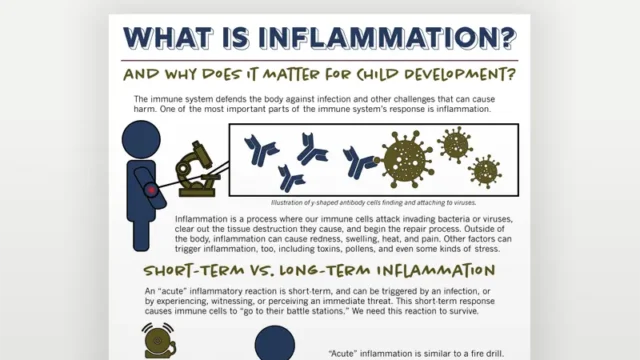What Is Inflammation? And Why Does it Matter for Child Development?

Inflammation is a critical part of an immune system’s response to invaders and threats; it enables our bodies to attack infections and heal the damage they cause. Inflammation can also be triggered by other experiences, such as witnessing traumatic events or undergoing stressful circumstances, and this response helps our bodies to react to and survive those experiences.
However, if our bodies experience constant stress, this can lead to too much inflammation. If our organs are constantly in contact with inflammatory substances, those organs can be damaged over time. If those organ systems are still developing, as they are in early childhood, the state of constant activation can cause them to adapt in ways that have impacts across the lifespan. This is how chronic inflammation can put us at greater risk for things like cardiovascular disease, diabetes, asthma, and even depression and dementia.
Chronic inflammation may also create greater risk for those who become infected with COVID-19. Many of the conditions that make it more difficult for a body to fight off COVID (such as heart disease, diabetes, and asthma) are related to chronic inflammation, which can be traced to adverse experiences in early childhood or even prenatally.
Fortunately, there are things we can do to support young children and their parents—from the prenatal period through the first few years of life—that can help to prevent chronic inflammation and reduce the risk for the lifelong health conditions it can cause. Things like reducing the sources of stress that families experience, and supporting programs that enhance the wellbeing of all citizens can help our society reap benefits for years to come.
Read the Full Text of the Infographic
What Is Inflammation? And Why Does it Matter for Child Development?
The immune system defends the body against infection and other challenges that can cause harm. One of the most important parts of the immune system’s response is inflammation.
Inflammation is a process where our immune cells attack invading bacteria or viruses, clear out the tissue destruction they cause, and begin the repair process. Outside of the body, inflammation can cause redness, swelling, heat, and pain. Other factors can trigger inflammation, too, including toxins, pollens, and even some kinds of stress.
Short-Term Vs. Long-Term Inflammation
An “acute” inflammatory reaction is short-term, and can be triggered by an infection, or by experiencing, witnessing, or perceiving an immediate threat. This short-term response causes immune cells to “go to their battle stations.” We need this reaction to survive.
“Acute” inflammation is similar to a fire drill. Brief activation of stress response systems, followed by a return to balance, builds resilience. For a baby, this kind of reaction could be caused by hearing a sudden loud noise, a scare, or noticing the absence of a caregiver who soon returns to soothe. It’s like a fire drill that prepares children for an emergency but then restores order after a short time.
“Chronic” inflammation may be experienced over an extended period of time in environments that cause prolonged stress. Imagine if a child heard fire alarms nonstop for days, weeks, or months.
This prolonged physiological reaction puts inflammatory substances in constant contact
with multiple organs, which can disrupt them over time. Ongoing abuse or neglect, deep poverty, the stresses of systemic racism, or long-term exposure to pollution can lead to chronic inflammatory responses. And these responses can lead to or worsen conditions such as cardiovascular disease, diabetes, depression, and asthma.
Turning Off the Fire Alarms
We can all help to turn off the constant fire alarms of chronic inflammation. Doing so can improve children’s lifelong health and could even dramatically reduce the need for costly treatments for a wide range of health conditions. A healthier society and lower health care costs benefit us all.
We can support responsive relationships between children and their caregivers, advocating for things like paid family leave.
We can support strengthening core life skills that give children and their caregivers the tools to regulate and manage their environments.
We can reduce sources of stress by strengthening policies that help build wellbeing by addressing income, nutrition, housing, and medical needs.